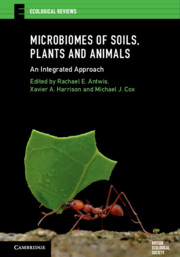
- Cited by 4
-
Cited byCrossref Citations
This Book has been cited by the following publications. This list is generated based on data provided by Crossref.
di Prisco, Guido Edwards, Howell G. M. Elster, Josef and Huiskes, Ad H. L. 2020. Life in Extreme Environments.
Antwis, Rachael 2021. A boom‐or‐bust approach—The ‘Glass Cannon’ hypothesis in host microbiomes. Journal of Animal Ecology, Vol. 90, Issue. 5, p. 1024.
Antwis, Rachael E. Beresford, Nicholas A. Jackson, Joseph A. Fawkes, Ross Barnett, Catherine L. Potter, Elaine Walker, Lee Gaschak, Sergey and Wood, Michael D. 2021. Impacts of radiation exposure on the bacterial and fungal microbiome of small mammals in the Chernobyl Exclusion Zone. Journal of Animal Ecology, Vol. 90, Issue. 9, p. 2172.
Su, Minqiang She, Yuanhang Deng, Ming Guo, Yongqing Li, Yaokun Liu, Guangbin Zhang, Hui Sun, Baoli and Liu, Dewu 2023. The Effect of Capsaicin on Growth Performance, Antioxidant Capacity, Immunity and Gut Micro-Organisms of Calves. Animals, Vol. 13, Issue. 14, p. 2309.
- Publisher:
- Cambridge University Press
- Online publication date:
- March 2020
- Print publication year:
- 2020
- Online ISBN:
- 9781108654418


